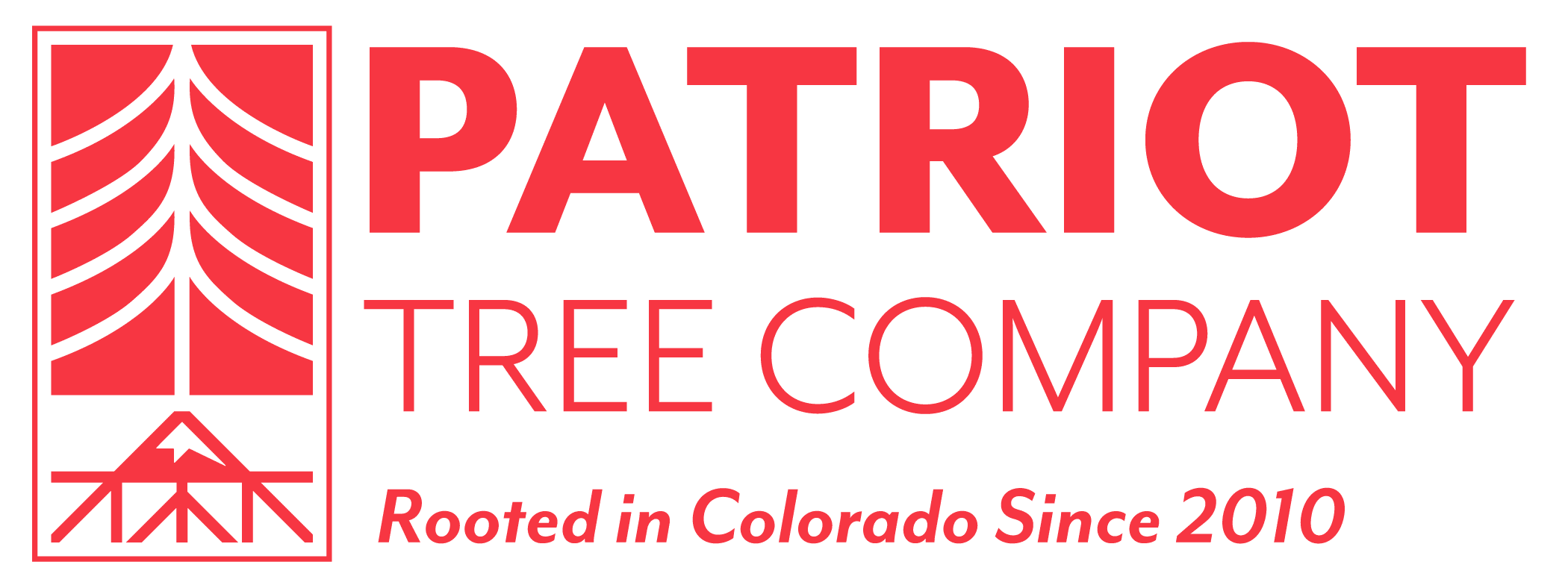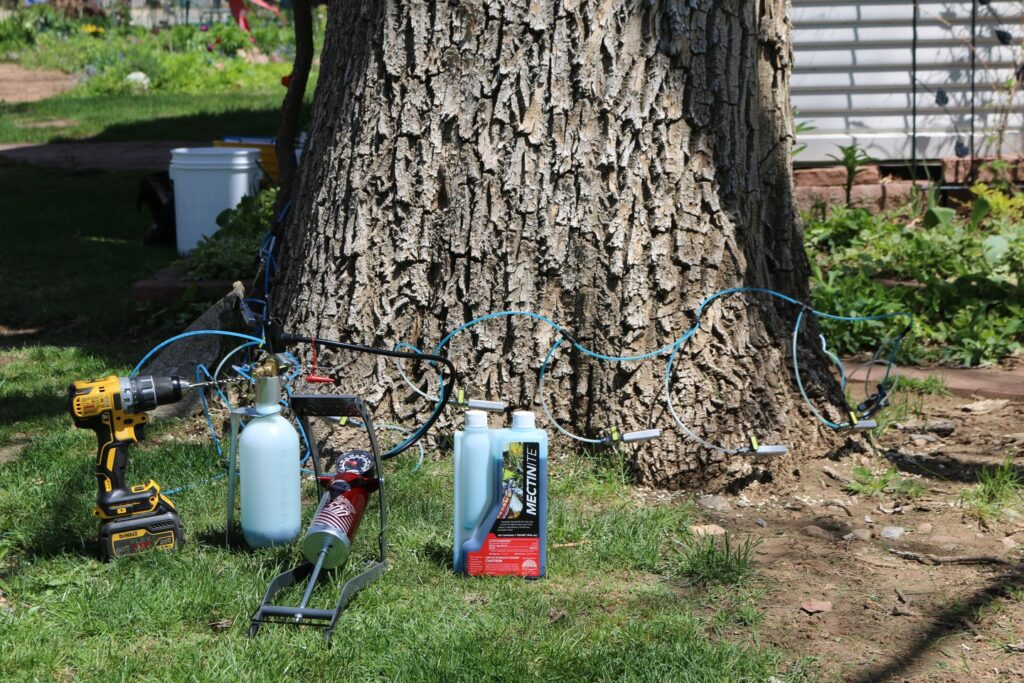Happy Spring! I am writing this post on the first full day of spring of 2024, the sun is shining, the birds are singing, and some tree species are just starting to break buds for the season. With the arrival of spring, it’s time to start thinking about tree health care services again. The most common insect pest in the Boulder area that we are currently treating trees for is a non-native, invasive wood boring beetle called Emerald ash borer (EAB). There is plenty of great information out there if you are interested, check out the Colorado State Forest Service’s site “Emerald Ash Borer: The Green Menace” for up to date info and a map detailing where and EAB has been detected in Colorado.
To Treat or Not to Treat: EAB Treatments
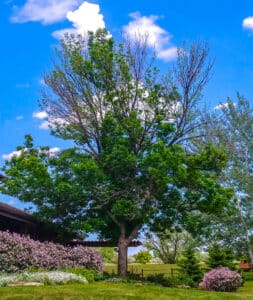
If you live in the Northern Front Range area of Colorado and have ash trees on your property (see: Ash Tree Identification if you are unsure), it is important for the value of your property and the health of the urban forest to make well informed decisions regarding your trees. Though EAB treatments exist, with some being very effective at suppressing EAB populations in trees, it’s not my belief that we should be treating every ash tree. Some trees are either in poor locations, are already in poor health, and/or have poor structure. These ash trees should be considered for removal before any EAB treatments, pruning, or other maintenance expenses are incurred. And by all means, please replace it with an appropriate tree for the space. Remember, the best time to plant a tree is 20 years ago, so don’t delay.
***One quick note before I get into EAB treatments, I wanted to stress a fact that sometimes folks don’t consider when making decisions about their ash trees. Live trees provide more removal method options than completely dead and rotting trees, and are always safer to be working in, on, and around. Point is, don’t turn a $1,000 removal into a $5,000 removal because you let it die completely before dealing with it. You don’t want to pay that, and we don’t want to remove that tree. Be proactive with the management of ash trees on your property, it’s much cheaper than being reactive.***
Effective EAB Treatments Exist
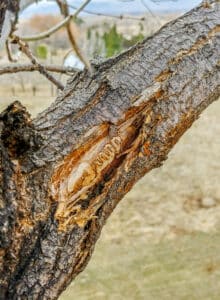
If you have ash trees on your property that are otherwise healthy, safe, and in good locations, it’s good to know that there are effective EAB treatments that exist. Due to the fact that EAB adults emerge, mate, and lay eggs on trees from late May through the end of August (a relatively long adult flight period), trunk and twig sprays would need to be applied 3-4 times throughout the season with a high mix rate to achieve adequate control. Tree spraying with contact insecticides is therefore not a cost effective or ecologically ethical option for EAB treatments. Lilac ash borer, on the other hand, has a relatively narrow adult flight period for around 30 days in April and May. A well timed trunk and twig spray is the most effective and low cost option for control of that insect pest.
So the best options for EAB treatments fall into a category of insect control chemicals known as systemics. Systemic chemicals are absorbed by tree tissues and translocated throughout the tree, primarily in the outermost rings of xylem tissues (wood). Systemic chemicals are applied either by putting them in the soil around the base of the tree (soil injection) or by injecting them directly into the trunk of the tree (trunk injection). There is a method of applying systemic chemicals by spraying them on the trunk of the tree to be absorbed into tree tissues that way, but this is not as effective as soil or trunk injection, and is usually only appropriate to treat large numbers of trees quickly and cheaply.
Using Soil Applied Methods for EAB Treatments
Soil applied systemic chemicals are commonly used for EAB treatments. These soil injections are applied near the base of the tree and rely on the tree’s fine feeder roots to absorb the chemical. Because of this, trees that are well watered or that have recently received a good amount of natural precipitation take up soil applied systemic chemicals much better than drought-stressed trees, and the treatment is much more effective.
There are a few pros and cons to using soil applied systemic chemicals for EAB treatments. Pros include: 1) relatively easy and inexpensive application, 2) limited environmental exposure (compared to spraying), and 3) no need to drill into and damage trees during application. Cons of these type of EAB treatments include: 1) They take 30-60 days to be effective in the trees, 2) they are not as effective as trunk injections (90% for soil applied vs. 95-99% for trunk applied), and 3) the most effective chemical for these types of EAB treatments is in the neonicotinoid class of pesticides (active ingredient is called imidacloprid).
***A note about Patriot Tree Company’s use of neonicotinoids in EAB treatments: Due to the general consensus and science showing that neonicotinoid use can contribute to significant declines in beneficial pollinators in areas where they are used heavily, we use neonics very sparingly and only in situations where we believe the benefits outweigh the risks. Ash trees rely on the wind as their way to get pollen to pistil, not insects. So while there are always some risks associated with the use of any pesticide in the landscape, I believe treating smaller diameter ash trees with soil applied imidacloprid carries a relatively small amount of risk of harming pollinating insects in the area. We never use these chemicals on insect pollinated trees (i.e. fruit trees) and we never spray them (to avoid off target drift and potential contact with beneficial insects).***
Using Trunk Injection Methods for EAB Treatments
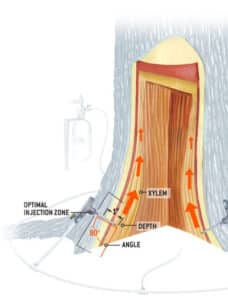
This brings us to direct trunk injection as a method for EAB treatments. Trunk injection requires drilling small holes (5/16” in diameter) around the base of the tree, and using a slightly pressurized system to inject a systemic chemical with an active ingredient called emamectin benzoate, into the drilled holes. The chemical is then absorbed directly by active xylem tissues. These are the tree tissues responsible for moving water and dissolved nutrients from the ground up to the leaves of the tree. Once the systemic chemical is absorbed by the xylem, it is moved up into the branches and leaves where it protects the tree from EAB feeding.
As with soil injections, there are pros and cons to using trunk injections for EAB treatments. Pros include: 1) Effective in the tree in around 30 days (quicker than soil injection), 2) has long effect in tree (effective for 2-3 years), 3) is a very effective way to get systemic chemicals into tree tissues, and 4) doesn’t require the use of neonicotinoid pesticides (though no chemical is perfect). Some cons of trunk injections include: 1) having to drill into the tree, which causes an injury to the tree, 2) more equipment and time intensive, and 3) requires better trained and knowledgeable applicators.
Minimizing Damage from Trunk Injections
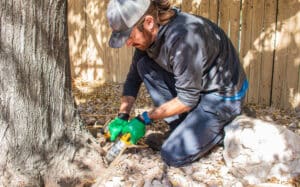
In my opinion, the biggest problem with trunk injected EAB treatments is having to drill the holes for application. In the past, I used to think that filling the drilled hole with a plastic plug during the injection was necessary to keep insect and disease organisms out and the chemical in. One of the primary reasons we currently use Rainbow Ecoscience as our vendor for these products is that they were the first to recognize that the plastic plugs were not necessary and actually cause more issues for the tree than they solve. We tried out their plugless system for a season, and I was so impressed with the difference that we have not gone back since. After many dissections of trees that have had both plugged and plugless EAB treatments performed, it was apparent to me that the plugs inhibit the trees natural systems for sealing off and compartmentalizing wounds. So the best practices for trunk injections include using plugless systems, only drilling the required number of injection sites, and using a very sharp (unfortunately replaced every 3-5 trees) high helix drill bit for every drill site only drilled to the required depth (0.5-1.0” past cambium).
If Your Trees were My Trees
In the end, I think that the benefit of a highly effective and long lasting treatment that doesn’t require spraying and doesn’t require neonicotinoids outweighs the issues caused by having to drill into the tree (assuming a plugless system is used). With a properly trained applicator and the right tools, damage can be minimized so that the holes have been completely healed over within a year of the application. If the tree to be treated is under 8” in diameter, we will likely recommend starting with soil injections to avoid drilling into a small tree, then move to a trunk injection once the tree is big enough.
After a little more than a decade of performing EAB treatments, I have performed almost every method of application commercially available and have spent countless hours researching in the literature and in the trees. The EAB treatments that Patriot Tree Company chooses to offer are a result and reflection of that time and effort, as well as my own personal ethics and beliefs about the use of chemicals in the landscape. It does not mean that these are the only options, or that there are not significant pros to other options out there. But all things considered, I believe these are the best options, and if your trees were my trees, these are the EAB treatments I would be considering.
There is so much more that I could discuss on this topic and EAB in general, but I will leave it at this for now. Please feel free to reach out to me at erik@patriottreeco.com if you would like any clarification on my points here, or reach out to the office at office@patriottreeco.com, 720-295-8733, or by clicking the “Request A Free Quote” button at the top of the page. Until next time, stay safe out there, and go out and enjoy spring on the Front Range!
Erik Gustafson
ISA Board Certified Master Arborist RM-7467B
Co-owner/General Manager, Patriot Tree Company
